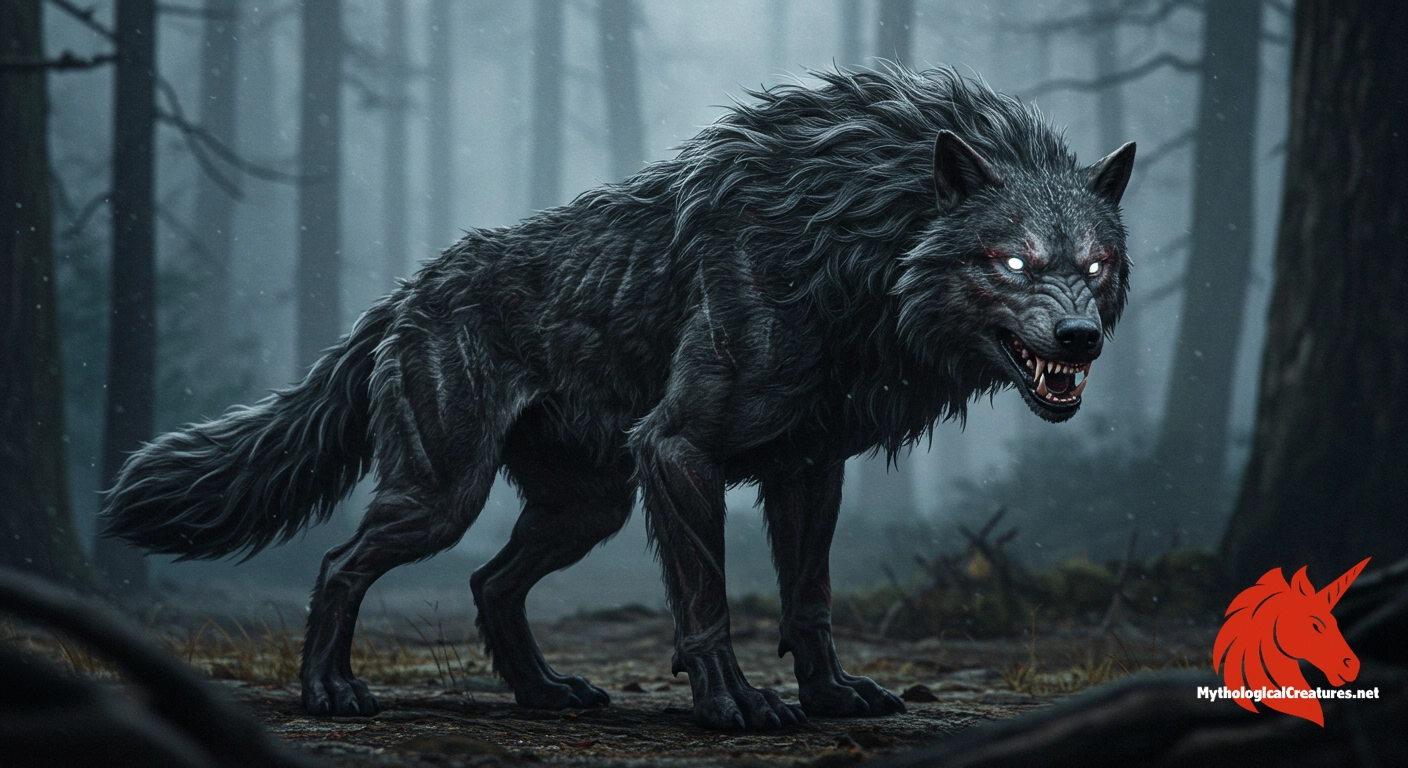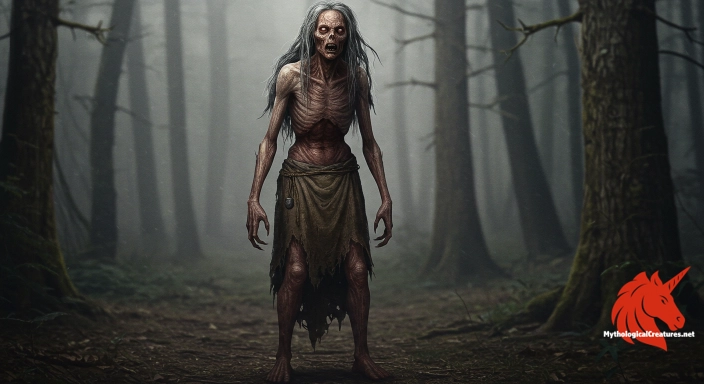Hati Hróðvitnisson: Hati Hróðvitnisson is a fearsome mythological wolf from Norse mythology that relentlessly chases the Moon across the night sky.

Hati Hróðvitnisson
Hati Hróðvitnisson - Hati's pursuit of Máni symbolises the inevitable destruction and cosmic cycle of Norse eschatology.
Origins & First Encounters
Hati Hróðvitnisson emerges as a striking figure within the Norse mythic landscape, a relentless wolf whose actions reverberate throughout the cosmos. His very name, imbued with the notion of enmity, captures the essence of a creature driven by an ancient, inexorable purpose. Rooted in tales of cosmic fate, he is intertwined with the eventual demise of celestial order, symbolising the chaotic forces that pave the way to Ragnarök. His origins lie in a turbulent family of formidable beings, being a progeny of Fenrir and an enigmatic giantess from the deep eastern forests. The mythic narrative envelops him in a rich tapestry of existential struggle, where night and day are locked in ceaseless conflict. His portrayal as the pursuer of Máni, the Moon, reinforces his significance as a harbinger of the world's ultimate transformation. The rich imagery of his chase across the night sky mirrors the Norse worldview, wherein cosmic events are deeply personal and palpably imminent. Each recounted saga weaves his character into a broader account of cosmic order and impending chaos. His portrayal exudes a power that is at once both natural and supernatural, challenging mortals to reckon with the inescapable cycles of time and destiny. The enduring legacy of his myth ensures that even as centuries pass, his image remains a vivid emblem of the struggle between light and dark.
Source Texts & Tale Variants
The primary narratives detailing Hati can be found in several seminal Norse texts that have shaped our understanding of the myth. Snorri Sturluson’s Prose Edda stands as the most comprehensive account, outlining his role as the fiercest of the wolf kin and the pursuer of the Moon. The poetic recensions in the Eddic poem Grímnismál contribute vital details, linking him to the daunting legacy of Fenrir. Various verses in Völuspá further echo his ominous presence by alluding to a wolf whose actions foreshadow cosmic upheaval. Alternate interpretations appear through references to Mánagarmr, a figure whose synonymous association with the Moon enriches the variant accounts. The narrative found in Vafþrúðnismál introduces nuances that differentiate the wolf destined to swallow celestial bodies from other canine figures. These texts collectively present a multifaceted view of his character, embedding him deeply in the mythic tradition of the Norse world. Subtle discrepancies among these sources add layers of mystery and invite ongoing scholarly and literary debate. The oral tradition and later manuscript copies have ensured that his tale has evolved, each version contributing its own flavour to his apocalyptic mission. This convergence of sources not only underscores the gravity of Hati’s role but also elevates him as a timeless symbol of fate and cosmic transformation.
Form & Powers
Visions of Hati often evoke the image of a colossal, fearsome wolf whose presence is as potent as the myths that describe him. He is imagined with an imposing stature, his muscles rippling beneath a coat that seems to capture the elusive essence of the night sky. His eyes, intense and luminous, are described as if they burn with the fervour of celestial fire, mirroring the relentless glow of the moon he chases. The animalistic ferocity of his form is complemented by a spectral aura that suggests a bond with cosmic forces. Renderings in traditional art have depicted him with elongated, powerful limbs and exaggerated features that amplify his otherworldly mien. His fur, dark and unkempt, is sometimes portrayed with streaks or markings that hint at the phases of the moon and the passage of time. The anatomy of Hati is simultaneously natural and monstrous, a blend of raw physicality with an ethereal quality that defies simple explanation. Artists and storytellers alike have envisioned his fangs as instruments of both destruction and destiny. His form exudes a blend of supreme agility and overwhelming strength, capable of spanning the limitless expanse of the heavens. In his every aspect, the physical portrayal of Hati is designed to instil a sense of both awe and foreboding, encapsulating the eternal struggle between order and chaos.
Regional Faces
Across the diverse realms of the Norse cultural sphere, depictions of Hati have adapted to local traditions while retaining his essential, ominous character. In Scandinavian sagas, his depiction often intertwines with local environmental features, suggesting an intimate connection with the wintry, harsh landscapes that mirror his relentless nature. Variations in regional tales sometimes place greater emphasis on the allegorical significance of his chase, using it to symbolise the inevitable march of time and decay. In Icelandic narratives, for instance, the descriptions of Hati incorporate subtle elements of nature’s raw brutality and the cyclical interplay between life and death. Northern European oral traditions have interwoven his myth with local legends of spectral wolves and hounds that haunt twilight hours. Communities have also infused Hati’s character with attributes that reflect local superstitions about the night, darkness, and impending disaster. These adaptations often stress the role of nature as both a nurturing and an avenging force, with Hati embodying the wild, unstoppable spirit of the world. Local storytellers have occasionally linked his myth with seasonal changes and celestial events, reinforcing the idea of an intricately connected cosmos. Even as the core narrative remains true to his origins, regional retellings underscore the dynamic evolution of myth-making. Such regional variations serve to remind us that myth is as much a product of local experience as it is a vessel of transcendent cosmic drama.
Cultural Parallels
Comparative mythology reveals that Hati’s role in Norse lore parallels similar canine figures found across various cultural traditions. His ceaseless pursuit of celestial bodies resonates with the global theme of hunting and cosmic balance, a motif that recurs in many mythologies. In Celtic folklore, spectral hounds and ghostly canines are often portrayed as emissaries of the Otherworld, embodying a liminal state much like Hati’s role in the cosmic cycle. Comparable figures in Eastern European legends speak of monstrous wolves as harbingers of cataclysmic change, emphasising the universal symbolism of the wolf as an agent of fate. The interplay of celestial pursuit found in his myth is reminiscent of other traditions where the cosmos itself is an arena for the eternal battle between order and disorder. His kinship with Fenrir and his designated role in Ragnarök find echoes in other mythic cultures that explore lineage and destiny as divine imperatives. The symbolic intersection between light and darkness, order and chaos, binds Hati to these parallel figures, establishing him within a broader, almost archetypal narrative. His mythic mission reflects a shared human anxiety about the ephemeral nature of cosmic order and the inevitability of destruction. Cross-cultural narratives often attribute to such creatures both a protective and a terrifying presence, making them critical in understanding the duality of existence. These comparative dimensions not only highlight the interconnectedness of mythic tradition but also affirm the enduring power of the wolf as a symbol across continents and ages.
Legacy & Modern Evolution
The evolution of Hati’s myth over the centuries reflects the dynamic interplay between ancient lore and modern reinterpretation. In early accounts, his portrayal was stark and fearsome, embodying the raw forces destined to herald an end to the world. With time, his figure has been reimagined in literature, art, and even in the realms of modern fantasy, serving as both a literal and metaphorical symbol of inevitable change. Contemporary creators have drawn on his relentless pursuit and cosmic significance to explore themes of destiny, environmental decay, and the cyclical nature of existence. His myth has transcended its original narrative, merging ancient symbolism with modern concerns and aesthetics. Modern illustrations and adaptations often amplify his spectral qualities, depicting him as a creature of both myth and metaphor. Hati has come to represent a bridge between the old world and the new, his image evolving alongside shifting cultural and environmental discourses. His legacy is continually reinterpreted in academic studies, popular media, and visual arts, each echoing the timeless allure of myth. As society grapples with the challenges of modernity, his relentless chase of the Moon fosters a potent metaphor for the unstoppable march of time. The continuing fascination with his character reaffirms the enduring power of myth to capture the imagination and reflect the deep-seated concerns of humanity.
Interesting Fact
An intriguing aspect of Hati is his role in the cosmic cycle; his relentless pursuit of the Moon not only underscores themes of fate and destruction in Norse mythology, but also illustrates the complex interplay between predatory instinct and cosmic inevitability.
Quick Creature Info
Origin:
Features:
Associations:
Our Mythic Legendary Rating:

Also Sometimes Known As:
Habitat:
Supernatural Powers:
Physical Attributes:
Abilities:
Behavior:
Lore:
References
Discover Another Mythical Legend You May Not Have Heard Of?
Uncover the mysteries of ancient folklore and expand your knowledge of legendary beings from cultures around the world.
Dare to Meet the Shtriga....
Mythical Disclaimer: The images and data on this site are derived from various historical and literary sources, but we have found that many myths often have multiple versions and interpretations across references, sometimes contradictory. As a result, these creature depictions are artistic interpretations—imaginative blends of folklore, legend, and a dash of AI guesswork. Because creature descriptions vary widely, our illustrations and accompanying information represent our best effort to honor mythology while bridging creative gaps. Enjoy these interpretations—just remember, we've done our best to respect the stories and validate available data, but in the realm of mythology, details often shift, imagination leads the way, and nothing is ever set in stone!
Curated by the Mythological Creatures Team (rev. May 2025)
